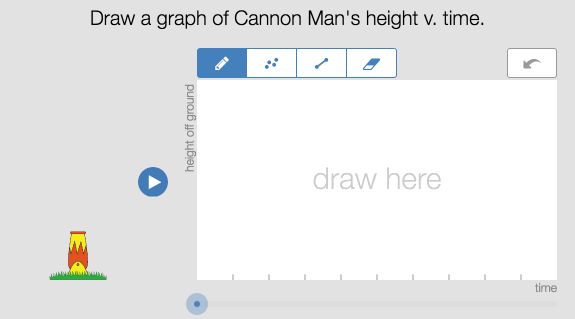Powerful media are useful in lots of contexts. For instance, paper and pencil are valuable in a classroom, in a conversation, in an art studio, and all kinds of other places.
When it comes to digital learning media, though, they’re often narrowly-scoped. We’ve been pushing hard for versatility as we explore and invent. I’ll explain why we think that matters and show some examples.
This great interactive from Desmos’s Function Carnival was designed for students to use in a classroom conversation. But it’s not really designed to exist outside the classroom: a student can’t bend it to some other problem they’re considering on their own later.

This interactive from Khan Academy’s exercise platform was designed as a way to input answers on a worksheet. It’s not designed to be used as part of a conversation with an instructor, or as a tool to think with, for instance.

By contrast, consider the graphing calculator. It’s much more personally empowering than these narrow interactives because it can be used in so many contexts, from homework assignments to visual doodles to self-directed exploration. The graphing calculator complements—not combats—media like paper and pencil, multiplying its possibilities. Its versatility gives students control, allowing them to find (or invent) individually meaningful uses for the tool.

Photo credit: Jack Rua
How might we design learning media for math that are as versatile and empowering as pencil and paper, while making the underlying mathematical concepts more usable, relevant, or deep?
We’ve been trying to make a medium (”Cantor”) which makes it easier to see and manipulate certain properties of quantities and arithmetic operations. But we’re deliberately not tying it to any one context: it’s a medium, not just an interactive.
You might use it to make a static animation about primality, or a video with speech on top of the animation:

Sure, we could ask students to use Cantor to compute or input an answer. But they might also use it as a tool for thought, either alone or in conversation with a peer. Here’s me and May-Li as “students” discussing parity via Cantor:
Or to support great live teacher–student conversation. Here’s May-Li as faux-student and Scott as coach:
Or even to support individual reflection and exploration by allowing recorded actions and student responses to inhabit the same canvas:
There are probably other useful contexts where Cantor is useful that we don’t know about—and that’s great! By intentionally keeping the medium versatile, we empower the student to find or invent personally meaningful uses.
Notes
regulars liked this
alexgoluk liked this
pristinaorg reblogged this from klr
rememorari liked this
koolinus liked this
krishaamer liked this
debbiediscovers reblogged this from klr
debbiediscovers liked this
 klr posted this
klr posted this